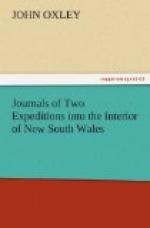June 6.—Proceeded down the river about four miles, when the boats were finally laden. The river in Wellington Valley had been swelled by the late rains, insomuch that the water below its junction with the Macquarie was quite discoloured. From the fineness of the soil, the rain had made the ground very soft, rendering it difficult for the horses to travel.
June 7.—Proceeded on our journey, both boats and horses being very heavily laden with our stores and provisions. The river rose but little. Our day’s journey lay generally over an open forest country, with rich flats on either side of the river: high rocky limestone hills ended occasionally in abrupt points, obliging the horses to make considerable detours. The hills were very stony, and so light was the soil upon them, that the rain rendered the ground very soft. The river had many fine reaches, extending in straight lines from one to three miles, and of a corresponding breadth. The rapids, although frequent, offered no material obstruction to the boats. The current in the long reaches was scarcely perceptible, and it appears to me that the difference of elevation between this station and the last is not considerable.
June 8.—The river expanded into beautiful reaches, having great depth of water, and from two to three hundred feet broad, literally covered with water-fowl of different kinds: the richest flats bordered the river, apparently more extensive on the south side. The vast body of water which this river must contain in times of flood is confined within exterior banks, and its inundations are thus deprived of mischief. About six miles down the river, a freestone hill ended on the north side of the river: I mention this, as the only stone of that description I had yet seen. The trees were of the eucalyptus (apple tree), and on the hills a few of the callitris macrocarpa [Note: Callitr. Vent decad.] were seen: the trees would furnish large and useful timber. Between eight and nine miles lower, passed the mouth of Molle’s rivulet, now a fine stream. At four o’clock halted for the evening on rather an elevated spot, overlooking the rivulet, and a most luxuriant country, on the south side of the river, well clothed with wood. The boats, during this day’s work, met with no obstructions that were not easily avoided; the rapids were not so numerous, neither were they so shoal as in the vicinity of the depot. Our sportsmen provided us with plenty of kangaroos, and a swan.
June 9.—This day the river ran to the north-west by north; about six miles below our halting-place it received Mary’s River, a pretty little stream. The country on the north side which we passed over was of various description; the hills barren and stony, with dwarf eucalypti, or gums, casuarinae, and a few of the sterculia heterophylla; the country hilly and open: some of the flats on the banks of the river were extensive and rich, and apparently not subject to floods. On the south side of the river, the




